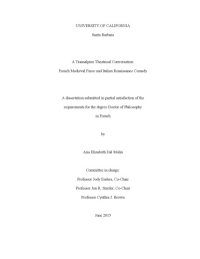
Ebook: A Transalpine Theatrical Conversation: French Medieval Farce and Italian Renaissance Comedy
Author: Aria Elizabeth Dal Molin
- Tags: Language literature and linguistics, Social sciences, Communication and the arts, Comedy, Farce, Italy, Literary academies, Renaissance, Theater
- Year: 2015
- Publisher: University of California
- City: Santa Barbara
- Language: English
- pdf
The French farce appealed to the experimental, avant-garde Tuscan dramatists of the sixteenth century as a model from which to appropriate a new kind of comic theater. Through the intercalation of Tuscan drama with the French farce, playwrights of the Congrega dei Rozzi in Siena and the Accademia degli Umidi in Florence created some of the first examples of hybrid genres of early modern theater; this intertextual phenomenon continued to gain popularity throughout the sixteenth and seventeenth centuries. By probing the connection between politics and the French farce, I show how inimitably suited this genre was to the needs of sixteenth-century Tuscan dramatists. This theatrical tradition allowed for the representation of key social tensions and contradictions that humanist comedy may otherwise have been unable to express theatrically without threatening to disrupt and undermine social stability. With an emphasis on interaction of theatrical forms, as well as a focus on the social, cultural, and historical factors that influenced these cultural productions, this dissertation offers a socio-semiotic reading of the construction of early modern European comedy, particularly in regard to humanism, imitation, and international cultural exchange.
This study analyzes the experimental use of units of theater from the medieval French farce tradition in Pierantonio Stricca Legacci's Cilombrino (1518), Salvestro Cartaio's Il Travaglio (The Torment) (1552), and Antonfrancesco Grazzini's L'Arzigogolo (The Quibble) (c. 1580). It asks questions such as: Did French military presence in Italy or the substantial Italian population in France have a specific effect on the theatrical productions of the sixteenth century? For what reasons would the French farce have appealed to experimental Tuscan literary academies of the sixteenth century, and how would Tuscan playwrights have come into contact with the French genre? In what ways were units of farce appropriated as models of progressive theater for and by these academies? Finally, what role did politics play in the comedic creations of the sixteenth-century theater? Could only laughter speak the truth to power as embodied by the French monarchy and the Medici regime? How did this hybrid comic theater critique the conventions of humanist imitation? By examining the formal relationships between medieval French farce and Italian Renaissance comedy through close investigation of thematic and textual borrowings, as well as stagecraft, this study authenticates Tuscan comedy as a "contact zone" for transalpine intercultural exchange, involving both material exchanges (print, letters, staging features, audio-visual effects) and semiotic ones (symbols, themes, topoi).
In exploring the use of specific units of French farce in Tuscan comedy, this study aims to elucidate the ways in which a revised poetics of imitation within select experimental literary academies of the Renaissance not only favored the transgression of classical models but also triggered the explosive growth of hybrid genres. Finally, intercalation of French farce in Italian comedy sheds new light on the integration of Renaissance Italian theatrical culture in France at the end of the sixteenth century and raises issues of "international relations" in the field of theatrical studies.
This study analyzes the experimental use of units of theater from the medieval French farce tradition in Pierantonio Stricca Legacci's Cilombrino (1518), Salvestro Cartaio's Il Travaglio (The Torment) (1552), and Antonfrancesco Grazzini's L'Arzigogolo (The Quibble) (c. 1580). It asks questions such as: Did French military presence in Italy or the substantial Italian population in France have a specific effect on the theatrical productions of the sixteenth century? For what reasons would the French farce have appealed to experimental Tuscan literary academies of the sixteenth century, and how would Tuscan playwrights have come into contact with the French genre? In what ways were units of farce appropriated as models of progressive theater for and by these academies? Finally, what role did politics play in the comedic creations of the sixteenth-century theater? Could only laughter speak the truth to power as embodied by the French monarchy and the Medici regime? How did this hybrid comic theater critique the conventions of humanist imitation? By examining the formal relationships between medieval French farce and Italian Renaissance comedy through close investigation of thematic and textual borrowings, as well as stagecraft, this study authenticates Tuscan comedy as a "contact zone" for transalpine intercultural exchange, involving both material exchanges (print, letters, staging features, audio-visual effects) and semiotic ones (symbols, themes, topoi).
In exploring the use of specific units of French farce in Tuscan comedy, this study aims to elucidate the ways in which a revised poetics of imitation within select experimental literary academies of the Renaissance not only favored the transgression of classical models but also triggered the explosive growth of hybrid genres. Finally, intercalation of French farce in Italian comedy sheds new light on the integration of Renaissance Italian theatrical culture in France at the end of the sixteenth century and raises issues of "international relations" in the field of theatrical studies.
Download the book A Transalpine Theatrical Conversation: French Medieval Farce and Italian Renaissance Comedy for free or read online
Continue reading on any device:

Last viewed books
Related books
{related-news}
Comments (0)